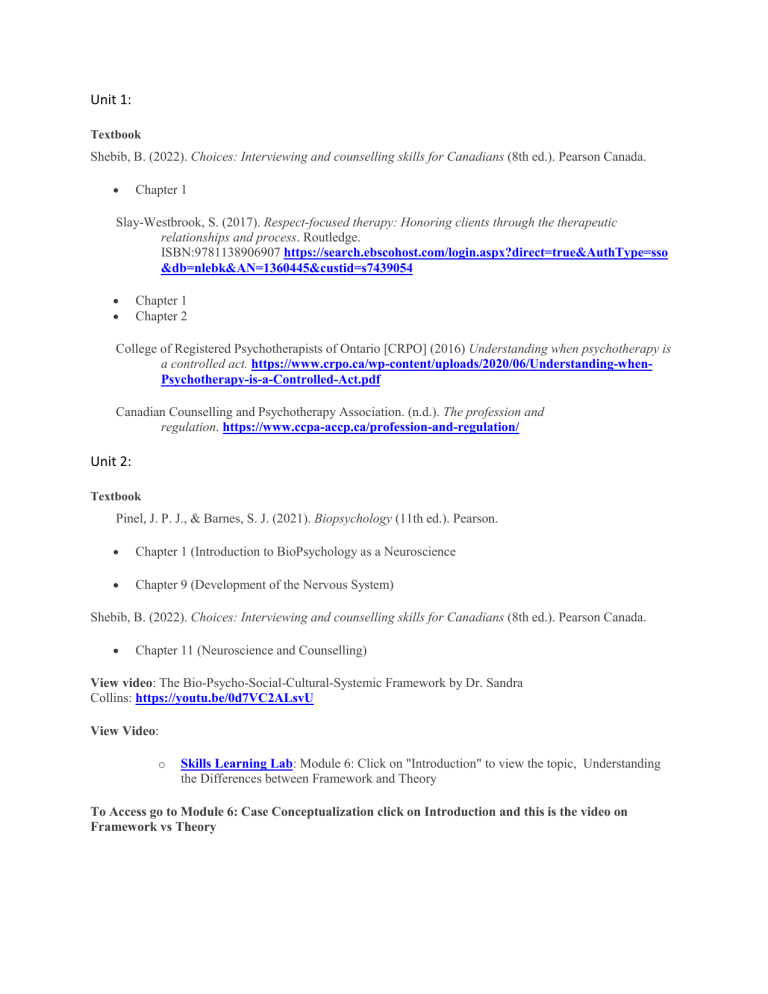Psychology Course Syllabus: Counseling, Biopsychology, Neuroscience
advertisement

Unit 1: Textbook Shebib, B. (2022). Choices: Interviewing and counselling skills for Canadians (8th ed.). Pearson Canada. Chapter 1 Slay-Westbrook, S. (2017). Respect-focused therapy: Honoring clients through the therapeutic relationships and process. Routledge. ISBN:9781138906907 https://search.ebscohost.com/login.aspx?direct=true&AuthType=sso &db=nlebk&AN=1360445&custid=s7439054 Chapter 1 Chapter 2 College of Registered Psychotherapists of Ontario [CRPO] (2016) Understanding when psychotherapy is a controlled act. https://www.crpo.ca/wp-content/uploads/2020/06/Understanding-whenPsychotherapy-is-a-Controlled-Act.pdf Canadian Counselling and Psychotherapy Association. (n.d.). The profession and regulation. https://www.ccpa-accp.ca/profession-and-regulation/ Unit 2: Textbook Pinel, J. P. J., & Barnes, S. J. (2021). Biopsychology (11th ed.). Pearson. Chapter 1 (Introduction to BioPsychology as a Neuroscience Chapter 9 (Development of the Nervous System) Shebib, B. (2022). Choices: Interviewing and counselling skills for Canadians (8th ed.). Pearson Canada. Chapter 11 (Neuroscience and Counselling) View video: The Bio-Psycho-Social-Cultural-Systemic Framework by Dr. Sandra Collins: https://youtu.be/0d7VC2ALsvU View Video: o Skills Learning Lab: Module 6: Click on "Introduction" to view the topic, Understanding the Differences between Framework and Theory To Access go to Module 6: Case Conceptualization click on Introduction and this is the video on Framework vs Theory Supplemental Reading/Resources Be encouraged to listen to the following Ted Talk by Dr. Barrett. https://lisafeldmanbarrett.com/2018/01/13/ted-talk-you-arent-at-the-mercy-of-your-emotions-yourbrain-creates-them/ You may also want to visit Dr. Barrett's academic work. https://lisafeldmanbarrett.com/academic-papers/ Additional Information I want to make sure you are aware of the Academic Support resources that are available to you - FOR FREE!! Interested?!?! Check out the Student Success Centre https://success.yorkvilleu.ca/academic-support This resource is not just helpful now (for the upcoming assignment) but also for future work. Example BPS Factors: Bio -- Genetic, hormonal, brain, glands, diet, exercise, developmental factors, pregnancy, medication, toxins, physical environmental factors in nature. (you need to discuss why these are factors, for example, what does physical exercise do for a person biologically?) What chemicals or hormones are increased due to physical exercise? Psycho -- Cognitive, thinking, perception, self-talk, emotion/mood/feelings, behavioural, self-regulation, substance use, personality style. (you need to discuss how the experience is impacting the person's internal thinking or feelings/mood?) Social -- Relationships, family, peers, school, workplace, religion, spirituality, financial resources, multicultural issues, human environmental factors. (you need to discuss how the social impacts the client and the client's thinking/feelings, and behaviours?) Cultural - Culture refers to the set of beliefs, practices, learned behaviour and moral values that are passed on, from one generation to another. Fashion, lifestyle, tastes and preferences, music, art, customs/practices, routines. (you need to discuss how the culture impacts the client and the client’s thinking/feelings, and behaviours?) * Click on this link: Sign up for the Team Resource Booklet Project NOW (the assignment is due in Week 7) Read the Presentation on being professional in Team Work (Find on sign up page, link above) Unit 3: Complete weekly discussion question posts Review APA 3-Part Series: Part II Textbook Pinel, J. P. J., & Barnes, S. J. (2021). Biopsychology (11th ed.). Pearson. Chapter 2 Chapter 3 Chapter 4 See video on Neuron activity. Think about how this has the potential for certain behaviours that we normally would contribute to psychological performance rather than biological performance. https://www.bing.com/videos/search?q=neurons+and+impact+on+psychological+behaviour++video&vie w=detail&mid=4E19381E40779AB573A24E19381E40779AB573A2&FORM=VIRE In Study Section Case of Jane (Part 1): Jane (she/her) comes in for her first appointment and begins to address her primary issue: “I work at the City in the horticultural department, primarily a male population, with just a few of us women there. I am anxious in life and worried about what people think of me all the time. The guys at work often comment on what I wear or how I look, and often those comments are very degrading. I am not going to go to my superior as I don’t want to look like a child. It reminds me of when I was a child growing up and my mother always straightened my sweater, gave me a “cold look” of disapproval, told me I looked like a hussy, or my dad would criticize my figure. I just want to please my family, boss, and colleagues. My anxiety is through the roof, I find myself not sleeping, eating more, and just lying around. I am so disappointed in myself.” How do we examine “biological factors” with the case of Jane? To begin, counsellors must be open-minded and hear what the client is saying without judgment. SlayWestbrook (2017) suggests that our ability to allow the client to express and not be judged or shut down is one of the first principles toward building a respectful therapeutic alliance. We want to avoid any possible judgment. For example, when the client states that she is concerned about what people think about her, a counsellor would not ask her why that is so important or express surprise that she would worry about something like that. Instead, we would remain open and allow her to express her thoughts and experiences in order to build the relationship. The client's primary issue may be self-esteem. Example of Understanding Biological Factors. The client also expresses that she is not sleeping well (circadian rhythm or perhaps adrenal gland), not eating well (research what happens to our neurons/transmitters/other hormones when we do not eat well), and has a loss of energy (thyroid or adrenal gland) (these would be biological factors (neurons, transmitters, glands, circadian rhythm to mention a few). They are pre-existing, they tend to facilitate or contribute to or maintain the primary issue in the client's life). Pinel and Barnes (2021) discuss the importance of neural activity and how the brain functions best when we take care of it. It is important to determine the disruption of sleep, eating, and energy levels. We could also listen to what happens to the client when she experiences little sleep, appetite, and has lower energy. Therefore, we could start by focusing on one area, such as sleep, and explore paths to better address this biological factor and its impact on the primary issue. Unit 4: Textbook Pinel, J. P. J., & Barnes, S. J. (2021). Biopsychology (11th ed.). Pearson. Chapter 9 Chapter 10 Slay – Westbrook, S. (2017). Respect-focused therapy: Honoring clients through the therapeutic relationships and process. Routledge. ISBN:9781138906907 Chapter 2 https://search.ebscohost.com/login.aspx?direct=true&AuthType=sso&db=nlebk&AN= 1360445&custid=s7439054 Shebib, B. (2022). Choices: Interviewing and counselling skills for Canadians (8th ed.). Pearson Canada. Chapter 11 (p. 424) (read Mirror Neurons and compare Shebib to the Pinel & Barnes reading) Mirror Neuron Video https://www.bing.com/videos/search?q=mirror+neurons+explained+video&docid=607991817019332064 &mid=81D15CC0ACB50D31970681D15CC0ACB50D319706&view=detail&FORM=VIRE Weekly Studies and Tasks Read Case of Jane (Part 2) for an example of how to highlight and examine psychological aspects of a case Complete weekly discussion question posts Submit Micro-Assignment #1 Check your Yorkville email – this is around the time that Student Services check-in to see how you are doing in your program. Be sure to stay connected with your program advisor if you need any support or have questions about the program. Review the process for how to submit an AskYU ticket. Bookmark this link for future reference through your program: https://my.yorkvilleu.ca/ask Case of Jane (Part 2) Jane (she/her) comes in for her first appointment and begins to address her primary issue: “I work at the City in the horticultural department, primarily a male population, with just a few of us women there. I am anxious in life and worried about what people think of me all the time. The guys at work often comment on what I wear or how I look, and often those comments are very degrading. I am not going to go to my superior as I don’t want to look like a child. It reminds me of when I was a child growing up and my mother always straightened my sweater, gave me a “cold look” of disapproval, told me I looked like a hussy, or my dad would criticize my figure. I just want to please my family, boss, and colleagues. My anxiety is through the roof, I find myself not sleeping, eating more, and just lying around. I am so disappointed in myself.” Unit 4 In Study Section - How do we examine “psychological factors” with the case of Jane? Pinel and Barnes (2021) discussed in chapter 9 the impact of early experiences and the development of neurons have on a person’s lifespan. Jane’s early childhood experiences must be considered. How was she shaped by her parents? Or their relationship? A counsellor must continue to build the relationship while exploring the interaction between her past relationship and her current connection with others. This is also a good time to explore the inner thoughts that developed as a result of her childhood, such as self-evaluation and how she relates to others around her. In approaching Jane, the counsellor would validate her experiences and provide the client with opportunities to explore her experiences further, as Slay-Westbrook (2017) suggests. This would involve asking about their experiences with her parents and how this impacts her still today. The key is to give Jane therapeutic room to express herself. This provides respect for the client and further clarity for the counsellor. As Slay-Westbrook (2017) stated, this could be the first time Jane has experienced someone actually validating her experiences in a meaningful way and therefore building a foundation for the possible formulation of assessment and conceptualization. View Mental Health Certificate: Understanding Mental Health Unit 5: Textbook Slay-Westbrook, S. (2017). Respect-focused therapy: Honoring clients through the therapeutic relationships and process. Routledge. ISBN:9781138906907 https://search.ebscohost.com/login.aspx?direct=true&AuthType=sso&db=nlebk&AN=1360 445&custid=s7439054 o Chapter 8 (pp. 95-109) Shebib, B. (2022). Choices: Interviewing and counselling skills for Canadians (8th ed.). Pearson Canada. Chapter 2 (pp. 44-85) Weekly Studies and Tasks Read Case of Jane (Part 3): Highlight the Social Unit 5 Case of Jane (Part 3) Jane (she/her) comes in for her third appointment and expresses her continued exhaustion with her relationships at work. Jane begins to tell you some of the examples of these situations at work: “One woman told me that I dress in a provocative manner and need to have someone dress me before I come into the office! One of my male co-workers hears her say this to me and then pipes up that I can wear whatever I want as long as he likes it. Like I’m just there to appeal to his sexual senses. I feel uncomfortable and it is making me second guess everything that I’m doing. I hate to take this to my boss because I don’t want him to be upset with me or things get worse!” Cultural factor: Jane comes from a home where her mother and father told her that she dressed inappropriately. Social factor: Now Jane is experiencing a similar event in her social life where she feels judged by what she wears. Issue: Is Jane transferring some of her childhood experiences into her adult life experiences and has added stress due to unresolved issues from her childhood as well as now dealing with inappropriate behaviour of her co-workers? How has Jane's cultural upbringing impacted her life today? How do we examine “social factors” with the case of Jane? Share your reactions to this short video in your Discussion Question' answers, (https://kentanakalovesyou.com/videos/) drawing on the concepts of stereotyping and within-group differences, in particular. Bring your personal and professional selves into the discussion including the thoughts from the Worldview information in Shebib (2020) Table 2.3. Be honest about your experiences of being stereotyped or of applying stereotypes to others. In the case of Jane, because she dresses a certain way and is a woman, people make assumptions that impact her socially, creating distress and anxiety. This is similar to the video demonstration in What type of Asian are you? The scenario of Jane also involves a subtle, yet significant, impact as her social environment shapes her culture. Complete weekly discussion question posts. This is the halfway point in the course and time to reflect on what has been successful in your course thus far and where are areas of needed growth. Consider your grades and work produced. Now, let’s examine how this compares to the Discussion Question (DQ) rubric and expectations. Unit 6: Textbook Shebib, B. (2022). Choices: Interviewing and counselling skills for Canadians (8th ed.). Pearson Canada. Chapter 2 (Cultural Intelligence, pp. 44-85 same as unit 5) Collins, S. (2018). Culturally responsive and socially just counselling: Teaching and learning guide. Faculty of Health Disciplines Open Textbooks, Athabasca University. https://crsjguide.pressbooks.com/ Complete the following activity: https://crsjguide.pressbooks.com/chapter/cc1/#exploringpersonalidentity o View the illustration of the cultural dimensions, systemic factors, rationality, personal contextual factors, and *isms that feed into each of our cultural identities. Listen to the audio provided on this page. Reflect on the four questions being asked. This will assist you in this week’s assignment as you answer the questions and provide further insights and references. Consider the term "culturally responsive socially just" (CRSJ) as alluded to in Shebib and the activity links above by Collins APA 7th edition support: Here are some supports from the library site https://yorkvilleu.libguides.com/apasupportcentre Weekly Studies and Tasks Read Case of Jane (Part 4) : Applying CRSJ Framework Complete weekly discussion question posts Unit 6 Case of Jane (Part 4) Jane (she/her) comes in for her fourth appointment and expresses her continued exhaustion with her relationships at work. She talks more about how her mother and father both criticized her as a young child and throughout her adolescence. Her mother was hypercritical of her look and presentation. The situation at work has increased her thoughts about her mother’s comments and her degrading comments. She mentions that her parents were first-generation immigrants from eastern Europe and that there was significant importance placed on presentation. How do we examine “cultural factors” with the case of Jane? Shebib (2022) pp. 48 & 55 read the Success Tip: “Counsellors have a responsibility to advocate for systemic change to reduce oppression and the misuse of power and improve clients’ access to services and resources”, p.48. Discuss your view of the counsellor’s role in advocating on behalf of a client, use the material from the text as you answer this. (Consider Shebib 2022, ch 1 & ch 2. We work at assisting a person to understand cultural identity as being separate from their own identity and how it also shapes a person in their identity along with understanding social justice. Consider what the cultural factors would be in the above scenario, you may want to discuss in the DQ for this week. Unit 7: Textbook Canadian Counselling and Psychotherapy Association. (2020). Canadian code of ethics for psychotherapists (3rd ed.). https://www.ccpa-accp.ca/wp-content/uploads/2020/05/CCPA2020-Code-of-Ethics-E-Book-EN.pdf Canadian Psychological Association. (2017). Ethical guidelines for supervision in psychology; teaching, research, practice and administration. https://cpa.ca/docs/File/Ethics/CoEGuidelines_Supervision2017_final.pdf College of Registered Psychotherapists of Ontario [CRPO]. (2011). Code of ethics. https://www.crpo.ca/wp-content/uploads/2017/08/Code-of-Ethics.pdf Shebib, B. (2022). Choices: Interviewing and counselling skills for Canadians (7th ed.). Pearson Canada. Chapter 1 (pp. 1-18) Unit 8: Required Readings Textbook Pinel, J. P. J., & Barnes, S. J. (2021). Biopsychology (11th ed.). Pearson. Chapter 18 Shebib, B. (2022). Choices: Interviewing and counselling skills for Canadians (8th ed.). Pearson Canada. Chapter 10 (pp. 348-391) Sperry, L., & Sperry, J. (2020). Case conceptualization (2nd ed.). Routledge. http://search.ebscohost.com/login.aspx?direct=true&AuthType=ip,sso&db=nlebk&AN =2572771&site=eds-live&custid=s7439054 Chapter 1 (pp. 1-11) Part 11 (pp. 87-115) Weekly Studies and Tasks Complete weekly discussion question posts. This week you will go to the Skills Learning Lab and review the following videos presented by Dr. Kress MACP Skills Learning Lab. (n.d.). Case Conceptualization & theories-Introduction [Video]. Yorkville University. MACP Skills Learning Lab. (n.d.). Case Conceptualization & theories-Level 1: Knowing the basics [Video]. Yorkville University. o The Case Conceptualization Module 6: (1) Introduction (2) Level 1: Knowing the Basics Unit 9: Required Readings Textbook Shebib (2022. pp. 19-39) discussed a worldview as being necessary for understanding our approach in therapy for the benefit of our clients. Review the activity about Cultural Distance – Similarity (Collins, 2018): https://crsjguide.pressbooks.com/chapter/cc3/#whoisdifferent Other Reading Review the Big 5 personality factors (John & Srivastava, 1999). John, O. P., & Srivastava, S. (1999). The big five trait taxonomy: History, measurement, and theoretical perspectives. In L. A. Pervin & O. P. John (Eds.), Handbook of personality: Theory and research. Guilford. Unit 10: Required Readings Textbook Slay-Westbrook, S. (2017). Respect-focused therapy: Honoring clients through the therapeutic relationships and process. Routledge. ISBN:9781138906907 https://search.ebscohost.com/login.aspx?direct=true&AuthType=sso &db=nlebk&AN=1360445&custid=s7439054 Chapter 9




